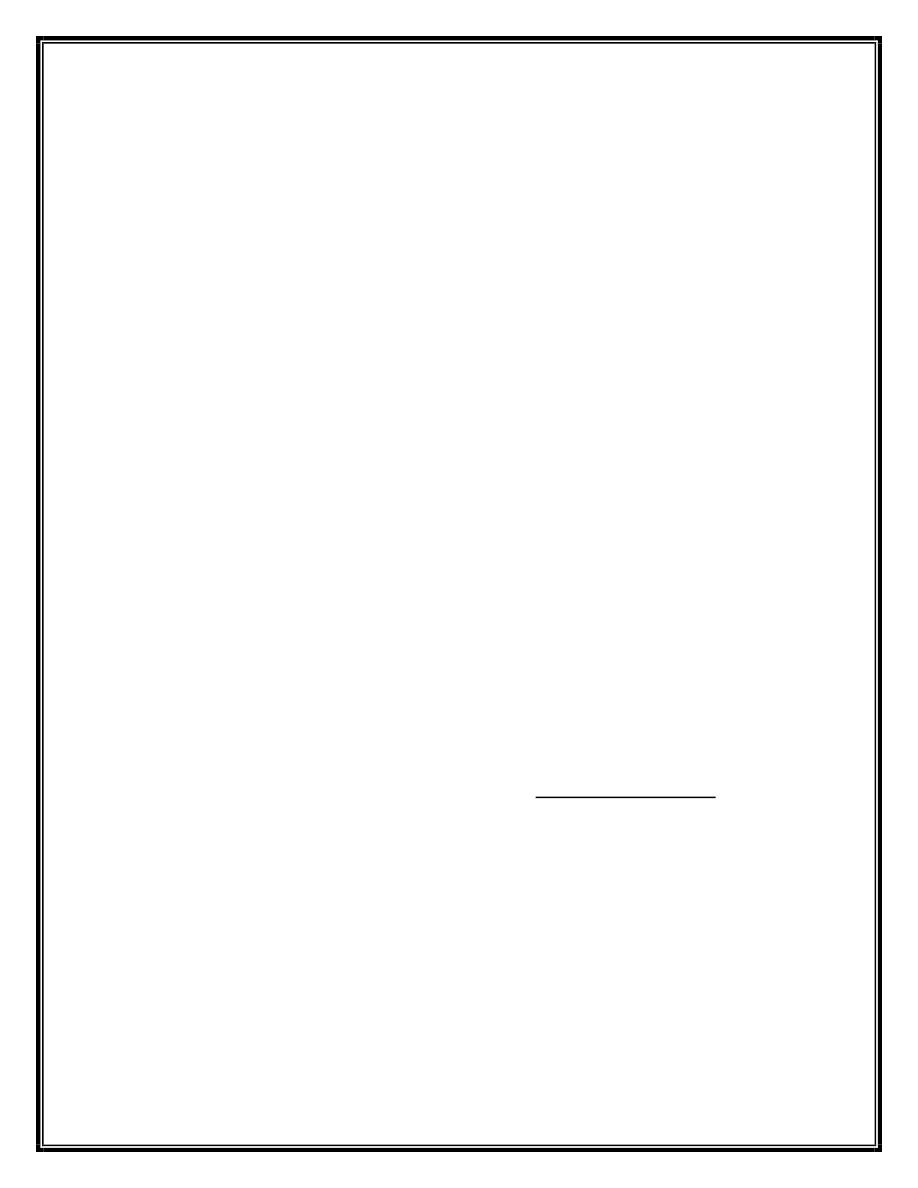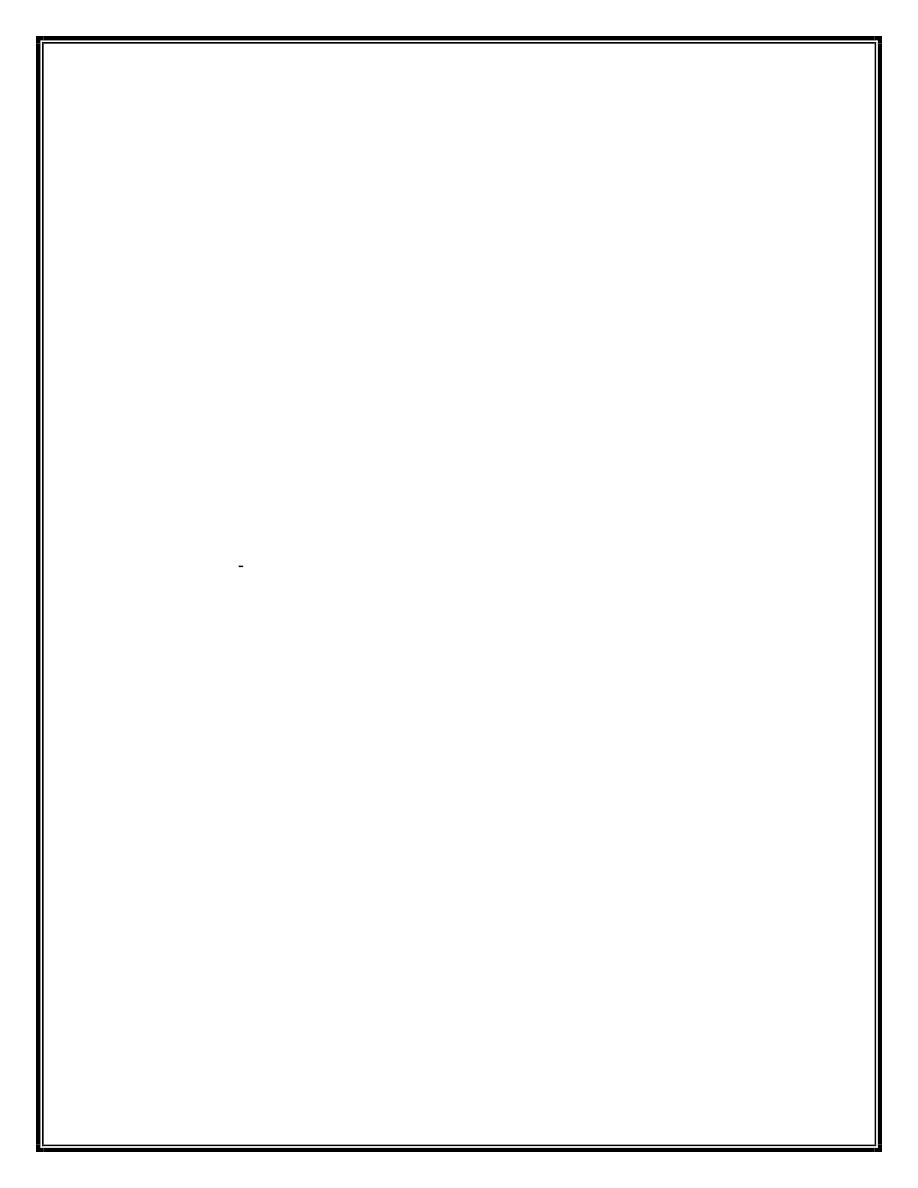
1
Disorders of hair and nail
Hair cycle:
Hair germs, or primary epithelial germs, are first observed
in embryos in the eye brow region and the scalp during the third month
of gestation. The general development of hair begins in the fourth fetal
month in the face and scalp and gradually extends in a cephalo-caudal
direction.
Normal human scalp hair can be classified according to cyclical phases of hair
growth into:
• Anagen (85%) last 2-6 years (average 3years), in which follicular matrix
will grow, divided, and become keratinized.
• Catagen (1%) last about from 1-2 weeks, in which follicular matrix will stop
its growth.
• Telogen (14%) last about 3 months, in which club hair is formed.
• Kenogen: lag period between loss of telogen hair & growth of new anagen
hair.
Normal scalp contains about 100000 hairs. Average hair shedding 100-150/ day.
The hair growth rate of terminal hair is 0.37 mm/day.
Hair types:
• Lanugo hair: fine hair covering fetal body.
• Vellus hair: fine thin light hair (unmedulated) found on adult extremities.
• Terminal hair: thick dark hair (medulated) found on scalp & beard area of
men.
Classification of alopecia (hair loss):
1. Non-cicatricial (non-scarring) hair loss:-
• Alopecia areata
• Telogen effluvium

2
• Anagen effluvium
• Androgenic alopecia
• Trichotillomania
• Syphilitic alopecia
• Vascular and neurological alopecia
• Endocrinological alopecia.
• Congenital alopecia.
2. Cicatricial (scarring) hair loss:-
• Infection: bacterial (folliculitis, carbuncle)
Fungal (kerion, favus)
Viral (varecilla zoster)
Protozoal (Leishmaniasis)
• Traumatic: burn
Radiodermatitis
Post operative
Hot comb alopecia
• Inflammatory: lichen planus
Discoid lupus erythematosus
Pseudopelade of Brocq.
• Sclerosing disorder: Morphea.
• Granulomatous disease: sarcoidosis
• Neoplasia : BCC, SCC
• Others

3
Alopecia areata
Alopecia areata (AA) is a common asymptomatic disease characterized by the
rapid & complete loss of hair in a sharply defined, usually round to oval patches.
Any hair-bearing surface may be affected. Alopecia areata (AA) accounts for about
2% of new dermatological outpatients.
Etiology:
Autoimmune disease: perifollicular inflammatory infiltrate of lymphocytes
(swarm bee appearance), association with other autoimmune diseases (DM, SLE,
Vitiligo).
Genetic factors: +ve family history (25%). HLA association (DR 4, 5, 11)
Infection: Recent work shows the possibility of cytomegalovirus infection in AA.
Emotional factor: stress may be an important precipitating factor in some cases
of AA.
Clinical feature:
Most patients report the sudden occurrence of one or several 1-5cm areas of
hair loss on the scalp that can be easily concealed by covering with adjacent hair.
The skin is smooth & of normal color or may have short hairs. The hair shaft in
AA is poorly formed and breaks on reaching the surface. The affected hairs that are
often found retained at the periphery of a lesion have a normal upper shaft and a
narrowed base—“exclamation point” hair. The eyelashes, beard, and, rarely, other
parts of the body may be involved. Gray or white hairs rarely involved with AA.
Loss may occur confluent along the temporal & occipital scalp, this is called
ophiasis.
Regrowth begins in 1 to 3 months and may be followed by hair loss in the same or
other areas. The new hair is usually of the same color and texture, but it may be
fine and white.

4
Clinical Types:
• Alopecia areata is a partial loss of scalp hair.
• Alopecia totalis is 100% loss of scalp hair
• Alopecia universalis is 100% loss of hair on the scalp and body.
• Migratory poliosis of scalp is a rare form of AA in which migrating
circulating patches of white hair will develop but never hair loss.
Nail changes: (10%) especially in long standing & severe cases.
• Uniform pitting.
• Transverse or longitudinal line.
• Red or spotted lanulae.
• Trachyonychia (all 20 nails become dystrophic).
• Onychomadesis ( idiopathic periodic shedding of nails).
Histopathology
A peribulbar lymphocytic infiltrate (around the lower portion of the hair
follicle) resemble “swarm of bees” is characteristic. The acute follicular
inflammation attacks the hair bulb in the subcutaneous fat. This inflammation
terminates the anagen stage, forcing the follicle into catagen. Since the bulge area
is spared, a new hair bulb and shaft grow at the start of the anagen stage, once the
inflammation has subsided or has been controlled. There is no scarring.
Prognosis:
The tendency is for spontaneous recovery in patients who are postpubertal at onset.
At first the regrowing hair are downy& lighter in color, later they are replaced by
stronger & darker hair with full growth.
Bad prognostic factors include: Patients with a family history of AA, young age
at onset, association with other immune diseases, atopy, Down syndrome, ophiasis,

5
and extensive hair loss (totalis & universalis), long duration more than 5 years, nail
dystrophy.
Treatment:
• Reassurance because AA can cause great psychological stress.
• Non-specific topical irritants, for example topical dithranol and phenol.
• Immune inhibitor, for example (topical, interalesional, systemic) steroids,
PUVA, cyclosporine.
• immune enhancers , for example contact dermatitis induction by DNCB,
squaric acid dibutyl ester (SADBE) and diphencyprone (DCP)
• Of unknown action, for example minoxidil.
•
Systemic targeted immune modulators (“biological therapy ”) have all been
tried with less success. More recently, promising results with oral
JAK/STAT pathway inhibitors (e.g. tofacitinib, ruxolitinib)
• Other cosmetic modalities such as wigs.
Telogen effluvium
It is excessive shedding of normal telogen club hairs from normal resting follicles;
rarely involve more than 50% of the hair & complete baldness do not occur. This
excessive shedding of Telogen hairs is most commonly occur 3-5 months after the
event that result in the premature conversion of many anagen hairs to telogen. Two
Types: Acute (within 6 months) & Chronic (more than 6 months). It can occur in
any age & more common in women.
CAUSES OF TELOGEN EFFLUVIUM
•
Shedding
of
the newborn
(physiologic)
•
Postpartum (physiologic)

6
•
Chronic
telogen
effluvium (no attributable cause or
illness)
•
Post febrile (extremely high fevers, e.g. typhoid, malaria)
•
Severe infection, Severe chronic illness (e.g. HIV disease, SLE), acute
blood loss.
•
Severe, prolonged psychological stress
•
Postsurgical (implies
major surgical
procedure)
•
Hypothyroidism, other endocrinopathies (e.g. hyperparathyroidism,
hyperthyroidism)
•
Crash or
liquid
protein
diets, starvation ,malnutrition
•
Drugs:
discontinuation
of
oral contraceptives - retinoids
(acitretin, isotretinoin) and vitamin
A
excess -
anticoagulants
(especially heparin) - antithyroid (propylthiouracil,
methimazole) -
anticonvulsants
(e.g. phenytoin, valproic
acid,
carbamazepine) - interferon-α-2b - heavy metals -
β-blockers (e.g.
propranolol)
Diagnosis
• pull test (pulled 40 hairs, if 4-6 club hairs comes out considered +ve)
• clip test (cutting 25-30 hairs above scalp surface , telogen hairs short and
small diameter)
• daily hair count (150-400/ day)
• skin biopsy (if more than 15% of hairs are in telogen phase )
Treatment:
Correct the causes, reassurance.
Topical minoxidil, antiandrogens (spironolactone, cyproterone acetate) in chronic
type.

7
Anagen effluvium
Diffuse hair loss involves the entire scalp seen frequently after the administration
of cancer chemotherapeutic agents such as antimetabolites, alkylating agents &
mitotic inhibitors. It is usually more rapid in onset and far more pronounced than
telogen effluvium. It results from rapid growth arrest of hair matrix cells due to the
antimitotic activity of these drugs that affect only growing (anagen) hairs. With
cessation of drug administration, the follicles resume its normal activity within a
few weeks as permanent destruction does not occur & the entire process is
completely reversible. Onset becomes apparent 1-2 months after chemotherapy.
A pressure cuff applied around the scalp or ice pad during chemotherapy can
minimize this problem & topical minoxidil can shorten anagen period.
Androgenic alopecia in men (male-pattern baldness)
Androgenetic alopecia (AGA) is an androgen-dependent, hereditary physical trait
resulting from the conversion of scalp terminal hairs into miniaturized vellus hairs
in a characteristic pattern. The frequency and severity increase with age, and at
least 80% of Caucasian men and 50% of women show evidence of AGA by age 70
years.
It is a physiologic reaction induced by androgens in genetically predisposed men.
The pattern of inheritance is probably polygenic. Thinning of the hair begins
during the teens, 20s or early 30s (at any time after puberty) with gradual loss of
hair chiefly from the vertex & fronto-temporal regions (professor angles), the
anterior hair line recedes from each side so that the forehead become high.

8
Eventually the entire top of the scalp may become devoid of hair. Several pattern
of hair loss occur, but the most common is the bitemporal recession with loss of
hair in the vertex (Hamilton pattern).
Pathophysiology:
There are two populations of scalp follicles: androgen-sensitive follicles on the top
(frontal, vertex) and androgen-independent follicles on the sides and back of the
scalp. In genetically predisposed individuals, and under the influence of androgens,
predisposed follicles (androgen-sensitive follicles) are gradually miniaturized;
therefore large pigmented hairs (terminal hairs) are replaced by thin depigmented
hairs (vellus hairs).
Skin androgen metabolism: Testosterone is converted to the more potent
dihydrotestosterone by 5α-reductase. Skin cells contain 5α -reductase (types I, II,
III).
Type I 5α-reductase is present predominantly in sebaceous glands and the liver,
whereas type II 5α-reductase dominates in scalp, beard and chest hair follicles, as
well as in the liver and the prostate. Type III is found throughout the epidermis and
dermis, but its functional role has yet to be elucidated.
Testosterone and dihydrotestosterone act on androgen receptors in the dermal
papilla. They increase the size of hair follicles in androgen-dependent areas such as
the beard area during adolescence, but later in life dihydrotestosterone binds to the
follicle androgen receptor and activates transformation of large, terminal follicles
to miniaturized follicles. The duration of anagen shortens with successive hair
cycles, and the follicles become smaller, producing shorter, finer hairs.

9
Androgenetic alopecia does not develop in men with a congenital absence of 5a-
reductase type II.
Treatment:
The desire for treatment varies. Some men accept the inevitable condition;
others find baldness intolerable.
1. Minoxidil (2%, 5%, 10%) spray or solution 1 ml applied twice daily.
Minoxidil was developed to treat hypertension. It increases the duration of
anagen, causes follicles at rest to grow, and enlarges miniaturized follicles. These
effects occur in 33% of patients.
Ideal candidates for treatment are men younger than 30 years of age who have
been losing hair for less than 10 years, less than 10 cm
2
bald area, contain at least
20 hairs per cm
2
. Benefits are seen in 6 to 12 months & treatment should continue
indefinitely to maintain response. The most frequently reported adverse reactions
are mild scalp dryness and irritation, and, rarely,
allergic contact dermatitis. Minoxidil-induced hair growth is commonly associated
with shedding of telogen hairs and a paradoxical worsening of hair loss ~4 to 6
weeks following initiation of treatment. This resolves with continued treatment.
2. Finasteride.
Finasteride taken orally 1mg/day is an effective oral therapy for
androgenetic alopecia in men. Finasteride blocks 5a-reductase type II, so that
inhibits the conversion of testosterone to dihydrotestosterone and decreases serum
and cutaneous dihydrotestosterone concentrations. This slows further hair loss,
inhibits androgen-dependent miniaturization of hair follicles and improves hair
growth. Efficacy is evident within 3 months of therapy. The drug produces
progressive increases in hair counts at 6 and 12 months. Approximately 20% to
30% of men do not respond.

10
It halts hair loss in 90% of patients, and partial hair regrowth
occurs in 65% of
those receiving finasteride. Continued use of the
product is necessary to sustain
regrowth, which is also true for topical minoxidil; halting the medication will be
associated with resumption of hair loss. Possible finasteride side effects include
reversible loss of libido, reduced volume of ejaculate fluid, and erectile
dysfunction, which occurs in ~2% of men.
3. Others:
Hair transplantation, Scalp reduction and flaps, hair weaves all can be used in
patients with common baldness.
Androgenic alopecia in women (female-pattern alopecia):
Chronic, progressive, diffuse hair loss in women can occur in their 20s and
30s is a frequently encountered complaint. The women have diffuse hair loss
throughout their mid-scalp sparing frontal hair line except for slight recession, so
this progressive decrease in hair density from the vertex to front of scalp given
what is called “Christmas tree pattern”. Evolution of the female type of androgenic
alopecia in to (Ludwig pattern).
The cause is now believed to be genetic predisposition with excessive response to
androgen hormone, although the circulating testosterone not elevated as a rule, so
when other sign of androgen excess are present (hirsutism, menstrual cycle
irregularity, acne…) hormonal assay should be done.
Treatment:

11
Topical minoxidil (2% solution, 5% foam) is approved for the management of
FPHL. FPHL can develop in the setting of hyperandrogenemia, and women may
benefit from oral contraceptives (to suppress ovarian androgen production),
spironolactone , or finasteride therapy.
Finasteride and spironolactone are contraindicated in pregnancy (cause
feminization of male fetus).
Dutasteride is a combined type I and type II 5α-reductase inhibitor. A dose of 0.5
mg/day leads to a greater reduction in serum and scalp DHT levels than does
finasteride at 5 mg/day. This suggests that dutasteride may be a more effective
therapy.
Hirsutism
It is the presence of terminal (thick, dark) hairs in females in a male-like pattern
such as on the face (beard & mustache), chest, and areola (androgen dependent
area). It affects between 5% and 10% of women (about 60% of Iraqi women).
Causes of Hirsutism:
A/ Hirsutism without virilization
1. Genetic: Polycystic ovary syndrome, Racial & Familial.
2. Physiologic: Puberty, Pregnancy and Menopause.
3. Endocrine: Hypothyroidism, Acromegaly.
4. Porphyria
5. Drugs: Androgens, Diazoxide, Glucocorticoids, Minoxidil, Oral contraceptives
(progestational components), Phenytoin.
6. CNS lesions: Multiple sclerosis, Encephalitis.

12
7. Idiopathic: 10-20% of hirsute patients have normal ovulatory function and
normal circulating androgen levels. These women may have increased numbers of
androgen receptors and/or increased 5α-reductase activity.
B/ Hirsutism with virilization
1. Ovarian: Polycystic ovary syndrome, Tumors.
2. Adrenal: Congenital adrenal hyperplasias, Tumors, ACTH-dependent
Cushing's syndrome
Virilization signs:
Acne and increased sebum production
Clitoral hypertrophy
Decrease in breast size
Deepening of the voice
Frontotemporal balding
Increased muscle mass
Infrequent or absent menses
Increased libido, bad odor
Pathophysiology:
The number of hairs per unit area is determined by genetic factors. Mediterranean
men and women have more body hairs per unit area than Asians. Hirsutism is
caused by high androgen level (from ovaries or adrenal glands) or by increased
sensitivity of hair follicles to the normal level of androgen. Free testosterone is the
androgen that causes hair growth. Androgens are produced by the adrenals &
ovaries. They are transported in the blood by sex-hormone binding globulins to the
hair follicles where they converted to their active form & bind to androgen

13
receptors. The activated hormones stimulate follicular proliferation, resulting in the
growth of thick dark terminal hairs.
Clinical Assessment of severity of hirsutism:
Done by Ferriman-Gallwey model which is based on distribution and number of
terminal hairs.
Approach to patient with hirsutism:-
1. History: Serious disease is suggested by onset of hirsutism will be after
puberty, rapid progression of hair growth, balding, deepening of the voice and
increased libido…other virilizing sign.
Idiopathic hirsutism, late-onset congenital adrenal hyperplasia (21-hydroxylase
deficiency) and some patients with polycystic ovary disease usually start at puberty
with slowly progressive hair growth. In Iraq, the most important cause of
hirsutism is polycystic ovary (PCO) & idiopathic.
2. Physical examination: Look for signs of virilization, Pelvic examination: 50%
of ovarian tumors are palpable, adrenal masses, Acanthosis nigricans suggests
insulin resistance, Examine for signs of Cushing's disease, others searching for the
responsible cause.
3. Investigations: Hormonal assay: testosterone (free &total), DHEA =
dehydroepiandrosterone;
DHEA-S
=
dehydroepiandrosterone
sulfate,
androstenrdoine. Other hormonal assay according causes ex: (thyroid disease,
PCO). In Iraq, most patients have normal hormonal assay.
4. Radiological: Abdominal US, CT scan,

14
Treatment of hirsutism:
Correct causes if possible, otherwise Hirsutism cannot be cured, only
suppressed.
1. Physical modalities: Shaving, Waxing and plucking, Bleaching, Depilatories
(Thioglycolates are available over the counter. They break down the hair shaft and
penetrate into the hair follicle to remove some of the hair below skin level.
Therefore this treatment lasts longer than shaving. Some women do not tolerate the
irritation), Lasers (Lasers selectively destroy the hair follicle without damage to
adjacent tissues), Thermolysis, Electrolysis, eflornithine Hcl (topical cream
slows hair growth by blocking ornithine decarboxylase which is an enzyme found
in the hair follicle needed for hair growth.
2. Pharmacological treatment:
* Androgen receptor blockers like Spironolactone, Flutamide, Cyproterone
acetate.
* Ovarian suppression by Combination oral contraceptives.
* Adrenal suppression by Low-dose corticosteroids (bed time).
* 5 α -reductase inhibition by Finasteride.
Anatomy and physiology of the nail:
The nail unit consists of several components. The nail plate is hard,
translucent, dead keratin. The nail folds include the skin surrounding the lateral
and proximal aspects of the nail plate. The proximal nail fold overlies the matrix.
Its keratin layer extends onto the proximal nail plate to form the cuticle. The
matrix epithelium synthesizes 90% of the nail plate. The lunula (white half-moon),
which is visible through the nail plate, is the distal aspect of the nail matrix. It is

15
continuous with the nail bed. The nail bed extends from the distal nail matrix to
the hyponychium. The hyponychium is a short segment of skin lacking nail cover;
it begins at the distal nail bed and terminates at the distal groove. The nail bed
consists of parallel longitudinal ridges with small blood vessels at their base.
Bleeding induced by trauma or vessel disease, such as lupus, occurs in the depths
of these grooves, producing the splinter hemorrhage pattern viewed through the
nail plate.
Acute paronychia:
The rapid onset of painful, bright red swelling of the proximal or lateral nail fold or
both may occur spontaneously or may follow trauma or manipulation. The most
important cause is staph aureus infections present with an accumulation of purulent
material behind the cuticle. A diffuse, painful swelling suggests deeper infection.
Treatment: drainage of pus, antistaphylococcal antibiotics both oral and topical.
Acute paronychia rarely evolves into chronic paronychia.
Chronic paronychia:
It is a common condition among Iraqi housewives. Chronic paronychia is not a
yeast infection, but rather an inflammation of the proximal nail fold. Chronic
paronychia evolves slowly and presents initially with some tenderness and mild
swelling about the proximal and lateral nail folds. Significant contact with
irritants is a major cause. Individuals whose hands are repeatedly exposed to
moisture (e.g., bakers, dishwashers, and dentists) are at greatest risk to develop this
condition. Manipulation of the cuticle accelerates the process. Typically, many or
all fingers are involved simultaneously. The cuticle separates from the nail plate,
leaving the space between the proximal nail fold and the nail plate exposed to
infection. Many organisms, both pathogens and contaminants, thrive in this warm,

16
moist intertriginous space. The skin about the nail becomes pale red, tender or
painful, and swollen. Occasionally a small quantity of pus can be expressed from
under the proximal nail fold. A culture of this material may reveal Candida or
gram-positive and gram-negative organisms. Candida is probably just a
secondary invader of the proximal nail fold rather than a direct cause of the
disease. It disappears when the physiologic barrier is restored (cuticle). The nail
plate is not infected and maintains its integrity, although its surface becomes brown
and rippled.
Treatment: The process is chronic and responds very slowly to treatment.
Avoiding exposure to contact irritants, with keeping the area dry as possible by
using gloves. Underling inflammation controlled by topical fungicide (miconazole)
& systemic antifungal (fluconazole 200mg/day for 1-4 weeks) to control the
infection with topical steroid cream twice daily for 2 weeks.
